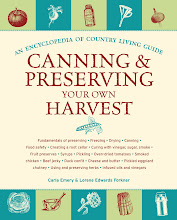Lately, I’ve been facing a difficult dilemma. I’ve recently come to the age where I need to start thinking about what I eat. As a kid (and even through high school and college, I have to admit) I pretty much ate whatever I wanted, whenever I wanted, and rarely experienced any consequences to make me consider changing my behavior. But as I begin to acknowledge my own adulthood, I’m realizing that processed foods—while often tasty and satisfying—might be doing more harm than good in my diet. Refined sugars, for example, are ever-present in packaged food and many dessert recipes, but serve no nutritional purpose. So here is the dilemma: how can I live without the unhealthy sweets for which I yearn on a daily basis?
Luckily, Carla Emery has the answer: honey.
Honey has been around longer than refined sugar and is easier for your body to digest. Honey is composed of simple sugars, mainly fructose and glucose. Best of all, you can substitute honey in nearly any recipe that calls for refined sugar and trade guilt for flavor!
Carla Emery has all kinds of advice for personal beekeeping to pollinate your crops and collect honey, but if you feel a bit squirmy about spending a lot of time with these buzzing pollinators (like I do), you can also buy wholesale honey direct from another beekeeper. If you are purchasing honey from a beekeeper, she suggests buying in 5-gallon quantities to supply an average family for a year.
Storing Honey
Honey keeps easily — better than just about anything else. Unlike most food storage, storing honey at a warm temperature, in a closed bottle, does not result in any loss of flavor. It doesn’t need to be frozen, canned, or even refrigerated. In fact, storing honey in a cool place can actually speed up the granulation process. (Your honey may crystallize into a stiff whitish texture—this is normal and doesn’t harm your honey, but each time you re-melt it your honey may lose some of its flavor and nutrition.) It keeps just fine in glass, plastic, pottery, or metal, inside or outside. But store where it won’t get warmer than 75 degrees Fahrenheit since above that temperature it may lose flavor and color (the higher above 75 degrees F, the faster the change). Ideally, pack your honey in wide-mouthed 1-gallon jars in comfortable room temperature (chilly, stiff honey won’t mix with other ingredients very easily).
Cooking and Baking with Honey
The sweet taste of honey tends to be more concentrated than that of sugar, so you can substitute less honey than the sugar called for and end up with your dish equally sweet tasting. You can substitute honey for sugar in any recipe, but because honey is a liquid you should then also decrease the liquid in the recipe. Carla Emery has a helpful cheat sheet for substituting honey for sugar when cooking:
· 2/3—3/4 cup honey = 1 cup sugar
· ¾ cup honey = add 2-3 T. liquid
· 1 cup honey = add ¼ cup liquid
· Baked goods with honey will brown faster than with sugar, so bake at a temperature 25 degrees lower than called for.
· Honey is acidic. If there is as much as 1 cup of honey in the recipe, you can add ½ t. baking soda (per 1 cup honey) and get a leavening action as well as neutralize the acidic quality.
· Honey is easiest to measure if your measuring container has first held the oil or other fat for the recipe, or if you first coat the spoon or cup with oil (or with nonstick pan-coating spray). Then the honey won’t stick in the measuring container and you’ll be able to get it all back out easily.
· Combine honey with other liquids in the recipe.
· If liquid isn’t called for in your recipe (like for cookies) add 4 T. additional flour for each ¾ cup honey.
· Cakes, cookies, and breads will be moist and stay fresh longer because of honey’s moistness.
And here are a couple of Carla Emery’s mouth-watering recipes to try without losing an ounce of sweetness!
Honey-applesauce cookies:
Cream together 1 ½ cup honey and 1 cup shortening. Add 2 beaten eggs and beat mixture until smooth. Add 2 t. soda to 2 cups applesauce. Sift in 2 t. cinnamon, 1 t. nutmeg, 1 t. salt, and 3 ½ cups flour. Stir in 2 cups quick-cooking oats (or rolled wheat), 2 cups raisins, and 1 cup walnuts. Drop on cookie sheet with a spoon. Bake at 325 degrees F for 10 minutes.
Honey-Fudge Brownies:
In a saucepan over low heat, melt together ½ cup butter, 2 squares unsweetened chocolate, ½ t. salt, and 1 t. vanilla. Mix well. Remove from heat. Blend in 1 cup honey, ½ cup unsifted flour, and 1 t. baking powder. Add 2 well-beaten eggs. Beat the mixture well. Pour into a thoroughly greased 9-inch-square pan. Bake at 325 degrees F for 35 minutes (or until done in center). Cool on wire rack 15 minutes before marking in 16 squares.








No comments:
Post a Comment